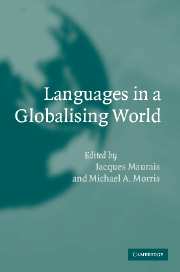Book contents
- Frontmatter
- Contents
- List of figures
- List of tables
- Notes on contributors
- Acknowledgements
- 1 Introduction
- Part I Global communication challenges
- Part II Major areas
- 7 Language geostrategy in eastern and central Europe: Assessment and perspectives
- 8 Languages and supranationality in Europe: The linguistic influence of the European Union
- 9 Regional blocs as a barrier against English hegemony? The language policy of Mercosur in South America
- 10 Effects of North American integration on linguistic diversity
- 11 Sociolinguistic changes in transformed Central Asian societies
- 12 Language and script in Japan and other East Asian countries: Between insularity and technology
- 13 Sub-Saharan Africa
- 14 Australasia and the South Pacific
- Part III Languages of wider communication
- Conclusion
- Index
14 - Australasia and the South Pacific
Published online by Cambridge University Press: 18 November 2009
- Frontmatter
- Contents
- List of figures
- List of tables
- Notes on contributors
- Acknowledgements
- 1 Introduction
- Part I Global communication challenges
- Part II Major areas
- 7 Language geostrategy in eastern and central Europe: Assessment and perspectives
- 8 Languages and supranationality in Europe: The linguistic influence of the European Union
- 9 Regional blocs as a barrier against English hegemony? The language policy of Mercosur in South America
- 10 Effects of North American integration on linguistic diversity
- 11 Sociolinguistic changes in transformed Central Asian societies
- 12 Language and script in Japan and other East Asian countries: Between insularity and technology
- 13 Sub-Saharan Africa
- 14 Australasia and the South Pacific
- Part III Languages of wider communication
- Conclusion
- Index
Summary
This chapter briefly reviews the past and present and examines the possible future language situation for the group of polities in the area bounded by Southeast Asia to the west, Australia and New Zealand to the south and Melanesia and Polynesia to the north and east. Kaplan (1999) has indicated some of the difficulties in defining this as an entity as this is a diverse region of the world. A summary of some salient points of the current language situation for each polity in the region is provided in Table 14.1. A number of these polities are discussed in Baldauf and Luke (1990) and Kaplan and Baldauf (2002), while references to the language situation can be found in Kaplan and Baldauf (1997).
Pool and Fettes (1998) and Fettes (Chapter 3 of this volume) have suggested six broad possible ‘geostrategies of interlingualism’ that might characterise the development of languages in the future. We examine each of these in terms of their past and present impact on the region, before providing what we believe are likely future general language development trends.
World Englishes
Table 14.1 indicates that English is the dominant LWC (language of wider communication) in the region with fifteen of the twenty polities giving the language some official role (also see Kaplan 1987). This is not to say that these Englishes follow one standard. In fact, it can be argued that one of English's great strengths has been that it is pluricentric; no one ‘owns’ English.
- Type
- Chapter
- Information
- Languages in a Globalising World , pp. 217 - 228Publisher: Cambridge University PressPrint publication year: 2003
- 3
- Cited by



